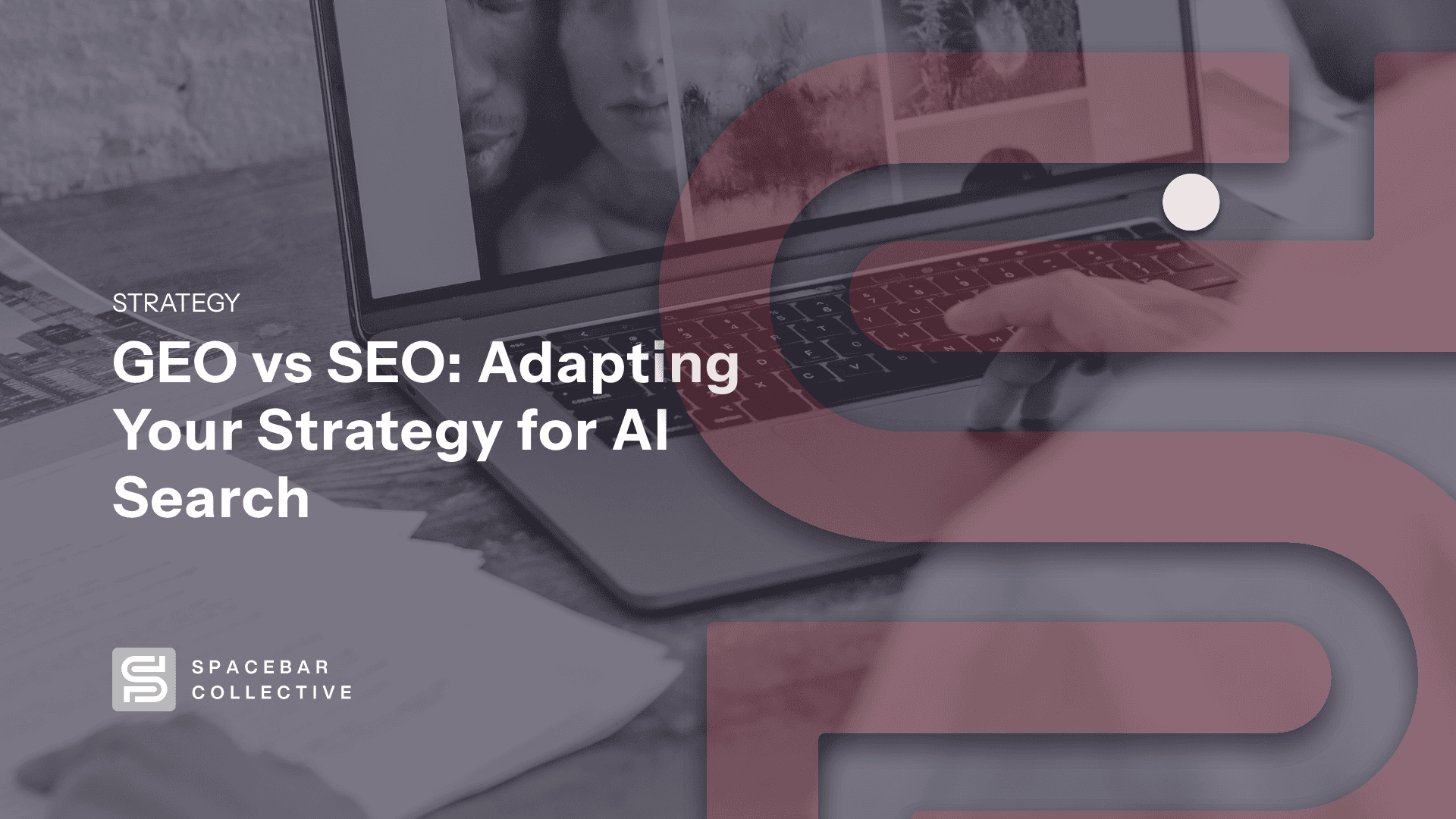For the longest time, being visible on Google and other search engines meant studying ranking factors, creating content to satisfy search intent, and building authoritative backlink profiles, a process aptly named search engine optimization (SEO).
Today, however, the very nature of online information discovery is evolving. Instead of the usual blue links from search engine results pages, generative AI chatbots like ChatGPT now provide direct, synthesized information to people’s search queries.
In response, SEO specialists are starting to optimize for mentions within AI responses, giving rise to a new discipline: Generative Engine Optimization (GEO). Now, does this mean your brand’s SEO foundation is suddenly obsolete? Not at all. In fact, studies have shown a strong correlation between high rankings and brand mentions in AI chatbots.
Below, we go over how GEO compares to SEO and discuss steps to develop a search strategy that succeeds across both classic and AI-powered search platforms.
What is Generative Engine Optimization (GEO)?
Generative Engine Optimization, or GEO, is the practice of optimizing your content and brand presence to appear in AI-generated responses. That means your audience discovers you not through a Google click, but through a hyper-specific question like: “What are the best b2b seo agencies for SaaS businesses in Canada?” answered directly by an AI chatbot:
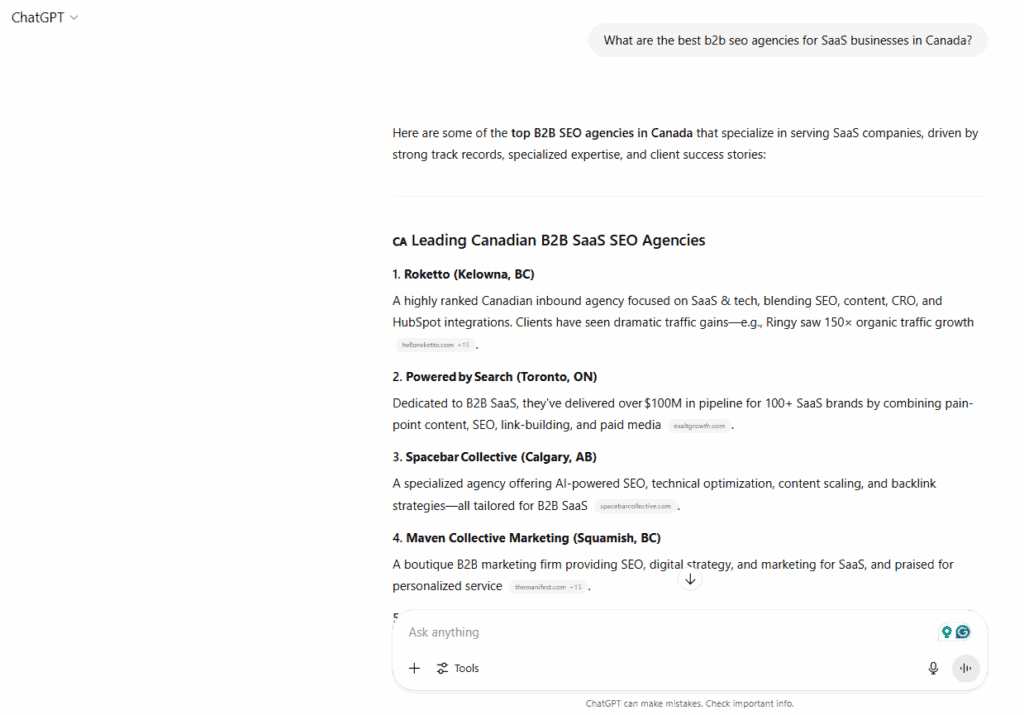
GEO shifts the focus from traffic to presence. You go from optimizing your brand for search engine algorithms to optimizing for the AI models that synthesize and summarize information to people at scale.
Why is GEO gaining so much attention now? Because generative AI is undeniably exploding. At the time of this writing:
- ChatGPT now receives over 400 million weekly active users
- Perplexity’s user base has grown more than five times in the past year
- Microsoft’s Copilot and Google’s Gemini are widely embedded across desktop, mobile, and search products.
In McKinsey’s State of AI Survey, 71% of respondents say their organizations regularly use gen AI in at least one business function (a jump from 65% in early 2024). And the signals go on and on. Simply put, momentum for AI search is building at a remarkable pace.
Granted, GEO is still in its early stages. The field remains experimental with no definitive playbook for success. But the widespread adoption is far too significant to ignore. And with several brands already enjoying the benefits of AI search visibility, not looking into GEO means you risk falling behind.
GEO Mechanics: How AI Accesses Knowledge
Before moving on, it’s important to clarify how generative AI tools gather information about brands. There are two primary approaches:
- Pre-training Data: This is the massive, historical dataset an LLM is initially built upon. It’s a vast snapshot of the internet up to a certain point, comprising billions of web pages, books, and other digital texts. High-authority, widely distributed content is inherently more likely to be part of this foundational training.
- Retrieval-Augmented Generation (RAG): When a user asks a question, RAG-based systems (like Google’s AI Overviews and Perplexity AI) first perform a real-time “retrieval” step, pulling relevant, authoritative information directly from the internet. They then use this fresh data to “augment” their knowledge and generate a precise answer, often with credit to the source.
This dynamic is precisely why strong SEO is fundamental for GEO. Your highly ranked, authoritative content is exactly what both pre-trained models and RAG-based AI systems are designed to retrieve and summarize.
SEO Fundamentals: The Foundation You Still Need
Search Engine Optimization (SEO) is the discipline of getting your brand and content to rank in search engines like Google and Bing.
Search engines work by crawling your site, indexing its content, and ranking pages based on hundreds of factors, from backlink profile to topical authority to user experience. Practically speaking, SEO focuses on three primary areas:
- On-page SEO: Your actual content, including headings, internal links, keywords, etc.
- Off-page SEO: Everything happening elsewhere that boosts your authority, like backlinks, brand mentions, social signals, etc.
- Technical SEO: Site architecture, structured data, mobile responsiveness, load speed, and more.
Despite the hype around GEO, your SEO foundation is still deeply relevant. In fact, it fuels many of the signals that AI systems learn from. Tools like ChatGPT and Gemini are trained on a massive slice of the internet, much of which comes from highly ranked, trusted content.
A recent study from Seer Interactive backs this up. Content that ranks well for competitive organic keywords tends to get cited more frequently in AI-generated responses. It’s not guaranteed, but the correlation is pretty solid at ~0.65:
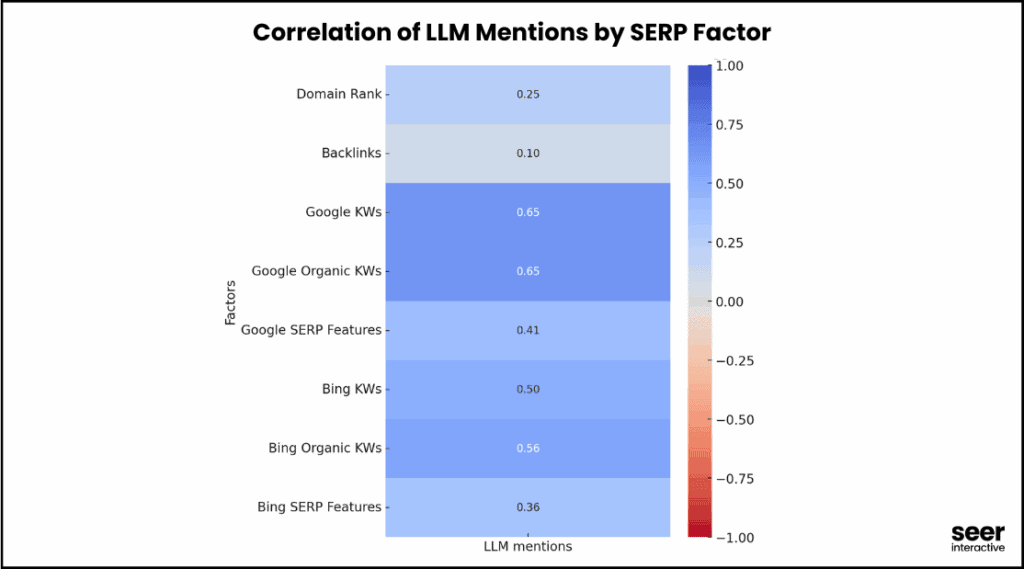
Source: Seer Interactive
That said, traditional SEO alone doesn’t get you visibility inside AI tools. A blog post that’s keyword-optimized but poorly structured or inaccessible to most audiences may rank, but get ignored by generative engines.
The inverse is also true. A clearly written, deeply cited post may not rank high on Google, but still shows up in ChatGPT or Gemini because it hits the right informational notes. This is why optimizing for both GEO and SEO requires different considerations.
Key Differences Between GEO and SEO
While both GEO and SEO aim to make your business discoverable, the goals, mechanics, and signals that matter in each are fundamentally different. Here’s a deeper look at how they compare:
| Focus Area | SEO | GEO |
|---|---|---|
| Primary Goal | To earn top rankings on Search Engine Results Pages (SERPs) for organic clicks. | To be directly cited, summarized, or recommended within AI-generated answers. |
| Audience | Human searchers navigating a list of links | AI systems (LLMs) and, by extension, humans seeking direct answers. |
| Core Mechanism | Algorithms rank pages based on relevance, authority, and user experience signals | AI models synthesize information, often prioritizing highly authoritative, well-structured sources |
| Performance Metrics | Organic traffic, click-through rate (CTR), keyword rankings, conversions, bounce rate | Brand mentions in AI outputs, citation frequency, sentiment in AI summaries |
| Primary Channels | Google, Bing, DuckDuckGo, etc. | ChatGPT, Google AI Overviews, Gemini, Perplexity AI, Copilot, etc. |
| Key Tactics | On-page and off-page SEO, backlink building | Precise definitions, stats, quotations, external mentions |
| Testing Methods | Rank tracking, traffic analytics | Prompt testing, entity audits, LLM response analysis |
Two Sides of the Same Search Coin
As mentioned, both GEO and SEO serve the same fundamental purpose: helping people find your brand and content when they need it. The difference lies in how they deliver that content. Seer Interactive put together a superb infographic to help put things in perspective:
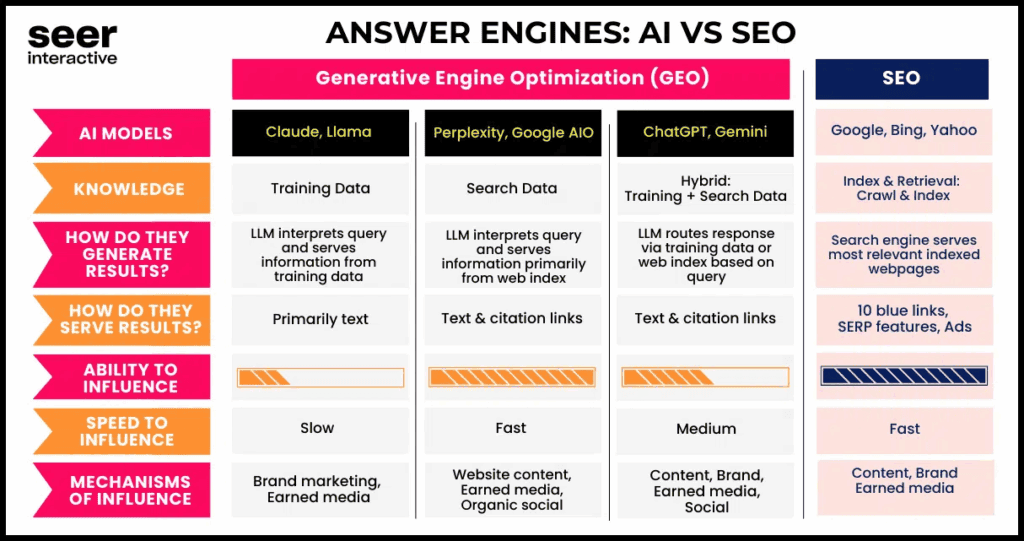
Source: Seer Interactive
Long story short, SEO helps your site rank in human-facing search results. GEO attempts to help AI systems understand, trust, and reference your content inside their answers. Now, let’s briefly examine a better approach than pitting both search channels against each other.
A Unified Approach to GEO and SEO
Rather than viewing GEO and SEO as competing strategies, a better approach echoed widely by SEO leaders is to treat them as complementary parts of a comprehensive search strategy:
- Your SEO-driven content provides the foundation that GEO builds upon.
- The authoritative backlinks you’ve earned for SEO also signal credibility to AI systems.
- The structured data you implement for rich snippets helps AI understand and cite your content accurately.
Both strategies belong to the same ecosystem. You’re still trying to help people find reliable information before they make a decision. Only now, those people might be getting their answers from AI systems.
Some call it GEO. Others call it AIO, AEO, or LLM SEO. Ashley Liddell from Deviation coined perhaps the best possible term for it, “Search Everywhere Optimization.” The acronym stays the same, but the meaning becomes broader and more fitting:
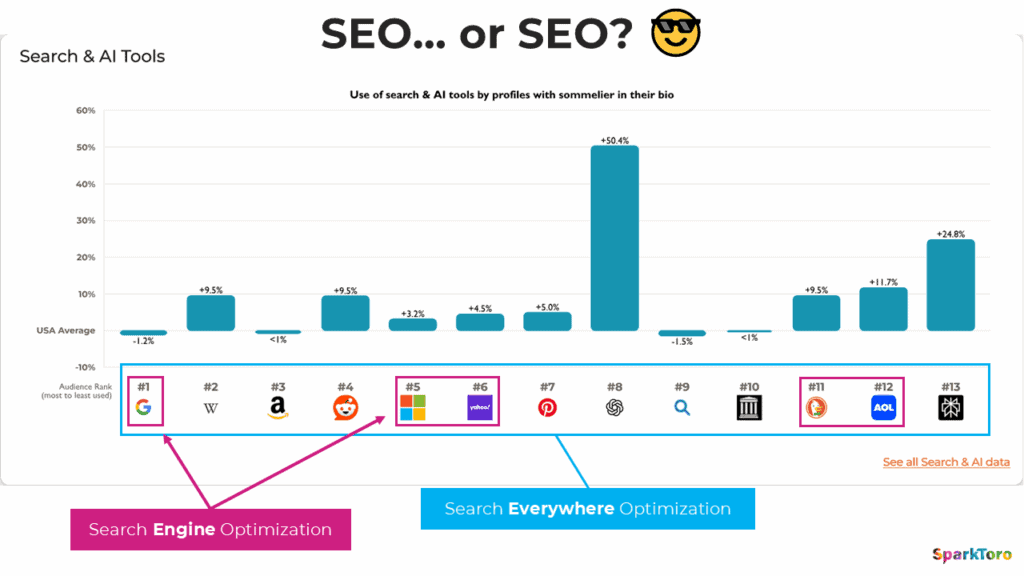
Source: SparkToro
With this framing, your brand and content are optimized for visibility everywhere. Not just on Google or in AI chats. But across YouTube searches, Reddit threads, shopping platforms, review aggregators, and emerging tools that haven’t even been released yet. Chances are, your SEO (and now GEO) efforts already do this.
This is the future of online search: not just ranking on search engines but being recognized and repeated across classic SERPs, AI-generated answers, and pretty much everywhere else.
How to Build a Unified Strategy for Classic and AI-Powered Search
You don’t necessarily need two separate strategies for SEO and GEO. You need one comprehensive approach built on sound fundamentals to make your brand and content recognizable by both search engines and AI systems. Here’s how to do that in practice:
Start with a Rock-Solid Technical SEO Foundation
Before you worry about chatbots and AI summarizers, your technical house needs to be in order. That means:
- Fast-loading pages that follow Core Web Vitals
- Logical site architecture that’s easy to crawl and index
- Strong internal linking to help establish topical clusters
- Proper use of structured data to reinforce meaning
Once all these are settled, you can then layer in trust signals. Expertise, author transparency, high-quality content, and credible sourcing still matter to both search engines and AI models.
Shift from Keyword Optimization to Concept Ownership
One of the biggest shifts between SEO and GEO is intent parsing. AI tools aren’t looking for keyword matches; they’re trying to answer questions with high confidence. That means your content needs to reflect structured, meaningful depth rather than surface-level fluff.
Here’s how to align content for both formats:
- Write with clarity. Concise sentences. Neat structure. Defined terms. No jargon fog.
- Use consistent product or brand naming. Some LLMs may treat “CRM Hub” and “Hub CRM” as different entities. Brand consistency is vital.
- Include proprietary information. AI tools tend to favor original data, expert quotes, useful statistics, and unique insights because they stand out in a sea of derivative content.
- Organize for retrieval. Short, well-labeled sections, clear headings, and digestible formatting help both web crawlers and chat-based models extract the right takeaways.
When you focus on clarity and authority, you make it easier for search engines and AI systems to understand what you do and where you stand.
Extend Brand Visibility Beyond Your Site
If your website is the only place your brand is mentioned, you’re invisible to most large language models. These systems draw conclusions based on what’s reinforced across the wider web, not what you say about yourself.
To build a presence across both traditional and generative search:
- Secure listings in public-facing, structured platforms (especially online directories like Wikipedia and industry databases)
- Maintain consistent profiles and company descriptions across professional networks
- Encourage third-party coverage and guest contributions on high-authority sources in your space
- Invest in PR that connects your brand to key topics in your industry, not just to events or features
Validate How You’re Being Understood
Finally, test how well your efforts are working. Use prompt-based research to see how AI tools describe your brand, which competitors they list you alongside, and whether your insights are being summarized or skipped.
Check if your most important concepts appear with authority or confusion. And if they don’t, it’s time to revise your content and approach accordingly. Search is no longer a one-algorithm game. But the goal hasn’t changed: be discoverable, be trusted, and be chosen.
Future-Proofing Your Search Strategy with Spacebar Collective

GEO may be new, but adapting to shifting search behavior isn’t. At Spacebar Collective, we’re already helping clients rethink SEO through that lens, without throwing out what works.
As the AI search era evolves, we’re testing, iterating, and reverse-engineering how LLMs actually retrieve and cite information. That means:
- Delivering stellar classic SEO services through high-quality content and backlinks
- Running prompt-based audits to see how brands show up in generative tools
- Tightening up content and brand presence for entity clarity
- Helping clients earn citations in places LLMs are known to trust
For our B2B SaaS clients, we’re already seeing measurable lifts, like doubling monthly signups from ChatGPT-sourced traffic and outpacing competitors in AI mentions.
But more than anything, we focus on the essentials done well: content with structure and substance, backlinks that signal trust, and smart positioning across classic SEO and generative AI search environments alike.
Curious how your brand appears in generative results today? We offer a free, comprehensive audit that shows your visibility across both SEO and GEO. And once you’re ready to build durable visibility across both search environments, we’re with you every step of the way. Get in touch.
Key Takeaways
The rise of GEO builds on classic SEO rather than replacing it. Online search today doesn’t just live on Google. It happens in AI chats, forums, niche engines, and wherever buyers seek clarity before making a move.
To stay visible, you don’t need to reinvent the wheel. Across many early studies today, a solid SEO foundation essentially acts as the springboard for GEO success. And that’s where we come in.
At Spacebar Collective, we help brands adapt without losing what works: SEO, GEO, and everything in between. We make sure your brand and message get seen and remembered by your ideal audience. Contact us today.
